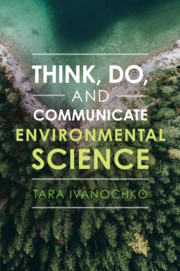Book contents
- Think, Do, and Communicate Environmental Science
- Think, Do, and Communicate Environmental Science
- Copyright page
- Contents
- Prologue
- Acknowledgements
- Introduction
- Part I Thinking Environmental Science
- Part II Doing Environmental Science
- Chapter 5
- Chapter 6
- Chapter 7
- Chapter 8
- Chapter 9
- Chapter 10
- Chapter 11
- 11 Comparing Data Sets
- Chapter 12
- Part III Communicating Environmental Science
- Epilogue
- Appendix: Working in Excel
- Glossary
- Index
- References
11 - Comparing Data Sets
from Chapter 11
Published online by Cambridge University Press: 23 April 2021
- Think, Do, and Communicate Environmental Science
- Think, Do, and Communicate Environmental Science
- Copyright page
- Contents
- Prologue
- Acknowledgements
- Introduction
- Part I Thinking Environmental Science
- Part II Doing Environmental Science
- Chapter 5
- Chapter 6
- Chapter 7
- Chapter 8
- Chapter 9
- Chapter 10
- Chapter 11
- 11 Comparing Data Sets
- Chapter 12
- Part III Communicating Environmental Science
- Epilogue
- Appendix: Working in Excel
- Glossary
- Index
- References
Summary
We have used the Mauna Loa monthly CO2 data set to isolate and characterize changes in the anthropogenic and biological contributions to atmospheric CO2 concentrations between 1960 and 2017. We have also studied variability in the seasonal cycle, driven by changes in photosynthesis and respiration from year to year. But is the CO2 record from Mauna Loa, a mountain in Hawaii, representative of the global variability in atmospheric CO2?
- Type
- Chapter
- Information
- Think, Do, and Communicate Environmental Science , pp. 155 - 168Publisher: Cambridge University PressPrint publication year: 2021

